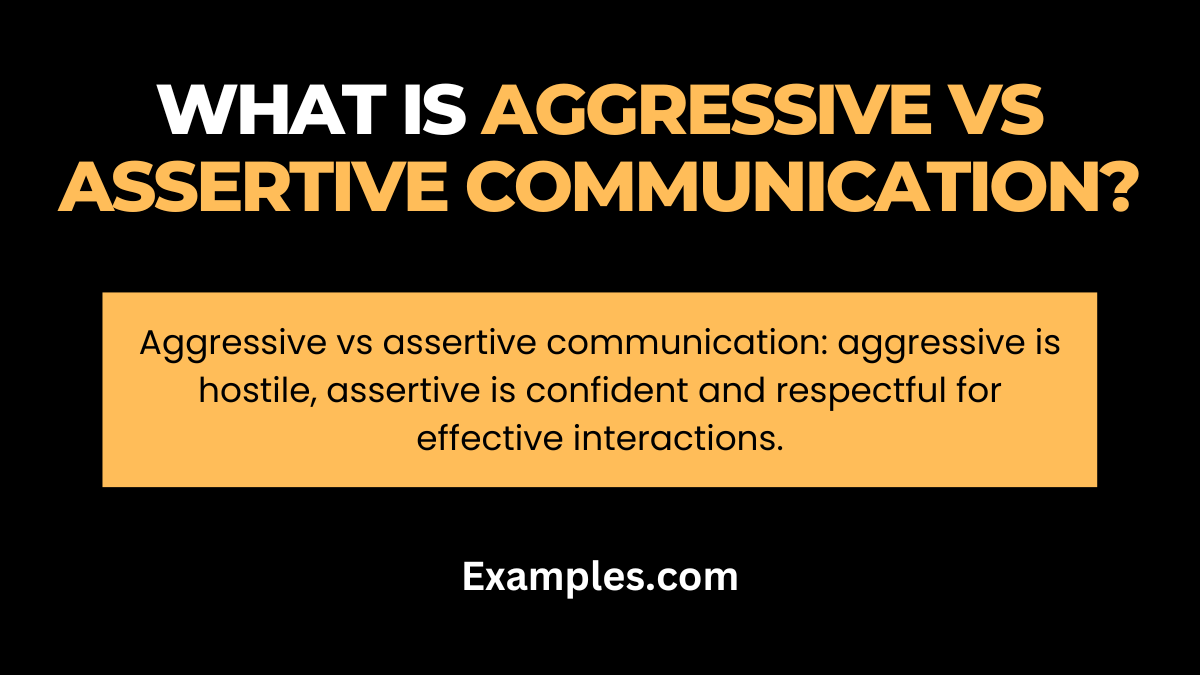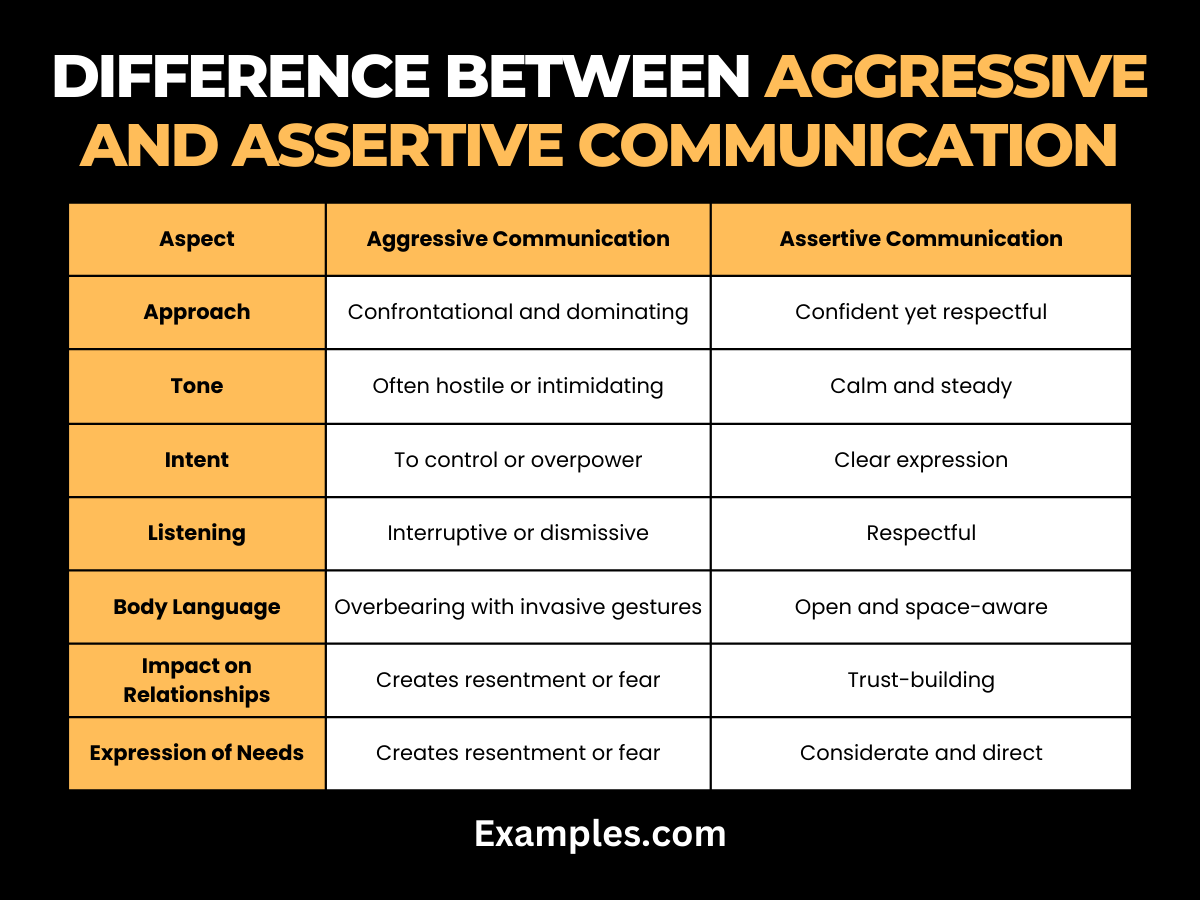Aggressive vs Assertive Communication – 9+ Examples
Aggressive vs assertive communication is a crucial distinction in effective oral communication. Aggressive communication often involves direct confrontation, intimidation tactics, and verbal attacks, which can be counterproductive and damaging. In contrast, assertive communication is about expressing oneself clearly and respectfully, without violating others’ rights. It includes being open, honest, and direct, but with a sense of empathy and respect. Understanding the difference between these communication styles is key to developing healthier, more productive interactions in both personal and professional settings.
What is Aggressive vs Assertive Communication?

Aggressive vs assertive communication distinguishes two fundamentally different ways of expressing oneself. Aggressive communication is characterized by hostile body language, verbal aggression, and demanding behavior, often leading to conflicts and strained relationships. Assertive communication, on the other hand, involves expressing one’s thoughts and feelings confidently and directly, while still respecting others. It’s a balanced approach, avoiding the extremes of passivity and aggression, and is essential for healthy and effective interpersonal interactions.
What is the Best Example of Aggressive vs Assertive Communication?

A prime example of aggressive vs assertive communication is the difference in handling a disagreement. An aggressive approach might involve yelling, interrupting, and using sarcasm or blaming, which can escalate tensions. In contrast, an assertive approach would entail calmly stating one’s position, listening to the other person’s perspective, and seeking a mutually beneficial resolution. This assertive approach fosters understanding and respect, while aggressive communication often leads to conflict and misunderstanding.
Difference Between Aggressive and Assertive Communication

Aggressive and assertive communication are distinct in their approach and impact. While aggressive communication often involves direct confrontation and hostile body language, leading to strained relationships, assertive communication is about expressing oneself confidently and respectfully, fostering positive interactions. Understanding these differences is crucial for effective interpersonal communication, especially in project management where clear and constructive communication is key.
| Aspect | Aggressive Communication | Assertive Communication |
|---|---|---|
| Approach | Confrontational and dominating | Confident yet respectful |
| Tone | Often hostile or intimidating | Calm and steady |
| Intent | To control or overpower | To express needs and opinions clearly |
| Listening | Poor, often interrupting or dismissing others | Good, shows respect for others’ viewpoints |
| Body Language | Overbearing, can include pointing or invading personal space | Open and relaxed, maintains appropriate personal space |
| Impact on Relationships | Usually negative, causing resentment or fear | Positive, builds trust and respect |
| Expression of Needs | Often forceful and demanding | Direct but considers others’ feelings and rights |
| Response to Disagreements | Typically blames and accuses | Seeks mutual understanding and solutions |
10 Examples of Aggressive Communication
Aggressive communication often damages relationships and hinders productive dialogue. It’s marked by verbal attacks, intimidation tactics, and a general lack of respect for others’ viewpoints. Such communication can manifest in various forms, including direct confrontation, sarcasm, and impatience, often leading to negative outcomes in both personal and professional settings.
- “You never do anything right!” Criticizing without offering constructive feedback.
- “Just shut up and do what I say!” Using verbal abuse to exert control.
- “You’re just too sensitive!” Dismissing others’ feelings and opinions.
- “I don’t care how you do it, just get it done!” Demanding results without consideration for challenges.
- “If you can’t handle this, I’ll find someone who can!” Threatening job security to enforce compliance.
- “You’re either with me or against me!” Forcing a divisive and confrontational environment.
- “This is all your fault!” Blaming without acknowledging personal responsibility.
- “You’re such a disappointment.” Insulting and belittling to undermine confidence.
- “Why can’t you be more like [person]?” Comparing unfavorably to demean.
- “That idea is just stupid.” Dismissing and ridiculing others’ suggestions.
10 Examples of Assertive Communication
Assertive communication is a healthy and effective way to express oneself, characterized by clarity, respect, and directness. This style respects both the speaker’s and the listener’s rights and feelings. It involves expressing one’s own needs and opinions honestly and openly while considering others’ viewpoints. Assertiveness leads to positive interactions and can strengthen relationships.
- “I understand your point, but here’s my perspective.” Expressing one’s viewpoint while acknowledging others’.
- “I appreciate your effort, but I need the task completed by tomorrow.” Setting clear boundaries and expectations.
- “I feel upset when I’m interrupted.” Expressing feelings directly without being offensive.
- “Let’s find a solution that works for both of us.” Seeking collaborative problem-solving.
- “I need some time to think about this proposal.” Requesting space for decision-making.
- “I would appreciate more support on this project.” Expressing needs clearly and respectfully.
- “Thank you for your suggestion, I will consider it.” Acknowledging others’ input while maintaining one’s stance.
- “I cannot take on this extra work right now.” Declining additional responsibilities without guilt.
- “Your feedback is valuable, but here’s why I chose this approach.” Defending a position with rationale.
- “Let’s discuss this issue calmly.” Initiating a constructive dialogue to resolve conflicts.
Comparison Between Aggressive and Assertive Communication
Comparing aggressive and assertive communication highlights the importance of tone, intent, and respect in interactions. While aggressive communication can lead to verbal attacks and manipulation, assertive communication focuses on expressing oneself honestly and listening actively, promoting healthy and effective dialogue.
- Expression of Opinions: Aggressive communication often shuts down others, while assertive communication encourages open dialogue.
- Handling Criticism: Aggressive communicators may respond with defensiveness or anger, whereas assertive communicators respond constructively.
- Conflict Management: Aggression escalates conflicts; assertiveness seeks resolution.
- Respect for Others: Aggressive communication often lacks respect, while assertive communication upholds it.
- Impact on Self-Esteem: Aggressive styles can diminish self-esteem, assertive communication enhances it.
- Problem-Solving: Assertiveness leads to effective problem-solving, aggression hinders it.
- Long-term Relationships: Aggressiveness can damage relationships; assertiveness strengthens them.
- Flexibility: Assertive communication is more adaptable, while aggressive communication is rigid.
Relationship Between Aggressive and Assertive Communication
The relationship between aggressive and assertive communication lies in the balance of self-expression and respect for others. Both styles aim to express needs and opinions, but the manner of expression differs greatly, impacting relationships and outcomes in varied ways.
- Self-Expression: Both styles seek to express self, but assertiveness does so respectfully.
- Perception by Others: Aggressiveness can be perceived as threatening; assertiveness as confident.
- Effectiveness: Assertive communication is generally more effective than aggressive.
- Adaptability: Assertive communicators adapt their style; aggressive communicators often don’t.
- Goal Achievement: Assertiveness is more likely to achieve goals without backlash.
- Conflict Resolution: Assertiveness resolves conflicts, aggressiveness often creates them.
- Emotional Regulation: Assertiveness involves emotional control; aggressiveness often lacks it.
- Response to Stress: Aggressiveness can be a stress response; assertiveness a learned behavior.
Understanding the difference between aggressive and assertive communication is crucial. This guide offers valuable insights and practical tips to help you navigate these communication styles effectively. By choosing assertiveness over aggression, you can express your needs and opinions confidently while respecting others’ perspectives. This balanced approach promotes healthier relationships, constructive problem-solving, and a more harmonious social and professional life.



